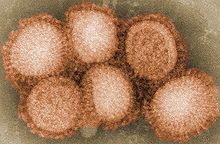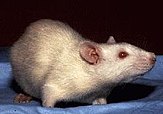Strain (biology)
In biology, a strain is a low-level taxonomic rank used at the intraspecific level (within a species). Strains are often seen as inherently artificial concepts, characterized by a specific intent for genetic isolation.[1] This is most easily observed in microbiology where strains are derived from a single cell colony and are typically quarantined by the physical constraints of a Petri dish. Strains are also commonly referred to within virology, botany, and with rodents used in experimental studies.
Contents
1 Microbiology or virology
1.1 Strain engineering
2 Plants
3 Rodents
4 Insects
5 See also
6 References
7 External links
Microbiology or virology

H1N1 viral strain, a priority target for pandemic research
A strain is a genetic variant or subtype of a microorganism (e.g., virus or bacterium or fungus). For example, a "flu strain" is a certain biological form of the influenza or "flu" virus. These flu strains are characterized by their differing isoforms of surface proteins. New viral strains can be created due to mutation or swapping of genetic components when two or more viruses infect the same cell in nature[2]. These phenomena are known respectively as antigenic drift and antigenic shift. Microbial strains can also be differentiated by their genetic makeup using metagenomic methods to maximize resolution within species[3]. This has become a valuable tool to analyze the microbiome.
Strain engineering
Scientists have engineered flu virus strains pandemic in humans in order to study their behavior. Funding for this research has been controversial as a result of safety concerns, and has been halted at times[4]. However, this research continues today.
In biotechnology, microbial strains have been engineered to establish metabolic pathways suitable for treating a variety of applications[5]. Historically, a major effort of metabolic research has been devoted to the field of biofuel production[6]. Optimized strains of E. coli are typically are used for this application. E. coli are also often used as a chassis for the expression of simple proteins. These strains, such as BL21, are engineered to minimize protease activity, hence enabling potential for high efficiency industrial scale protein expression. In the case of complex proteins including biologics, mammalian strains are typically used for expression. See Chinese hamster ovary cell.
Yeasts are the most common subjects of eukaryotic strain engineering, especially with respect to industrial fermentation[7].
E. coli is most common species for prokaryotic strain engineering. Scientists have succeeded in establishing viable minimal genomes from which new strains can be developed.[8] These minimal strains provide a near guarantee that experiments on genes outside the minimal framework will not be effected by non-essential pathways.
Plants
The term has no official ranking status in botany; the term refers to the collective descendants produced from a common ancestor that share a uniform morphological or physiological character.[9] A strain is a designated group of offspring that are either descended from a modified plant (produced by conventional breeding or by biotechnological means), or which result from genetic mutation.
As an example, some rice strains are made by inserting new genetic material into a rice plant,[10] all the descendants of the genetically modified rice plant are a strain with unique genetic information that is passed on to later generations; the strain designation, which is normally a number or a formal name, covers all the plants that descend from the originally modified plant. The rice plants in the strain can be bred to other rice strains or cultivars, and if desirable plants are produced, these are further bred to stabilize the desirable traits; the stabilized plants that can be propagated and "come true" (remain identical to the parent plant) are given a cultivar name and released into production to be used by farmers.
Rodents

The Wistar rat, which was the first developed rat model strain.
A laboratory mouse or rat strain is a group of animals that is genetically uniform. Strains are used in laboratory experiments. Mouse strains can be inbred, mutated, or genetically engineered, while rat strains are usually inbred. A given inbred rodent population is considered genetically identical after 20 generations of sibling-mating. Many rodent strains have been developed for a variety of disease models, and they are also often used to test drug toxicity.[11][12][13]
Insects
The common fruit fly (Drosophila melanogaster) was among the first organisms used for genetic analysis, has a simple genome, and is very well understood. It has remained a popular model organism for many other reasons, like the ease of its breeding and maintenance, and the speed and volume of its reproduction. Various specific strains have been developed, including a flightless version with stunted wings (also used in the pet trade as live food for small reptiles and amphibians).
See also
- Genetic isolate
- Race (biology)
References
^ DIJKSHOORN, L.; URSING, B.M.; URSING, J.B. (2000). "Strain, clone and species: comments on three basic concepts of bacteriology". Journal of Medical Microbiology. 49 (5): 397–401. doi:10.1099/0022-1317-49-5-397. PMID 10798550..mw-parser-output cite.citationfont-style:inherit.mw-parser-output .citation qquotes:"""""""'""'".mw-parser-output .citation .cs1-lock-free abackground:url("//upload.wikimedia.org/wikipedia/commons/thumb/6/65/Lock-green.svg/9px-Lock-green.svg.png")no-repeat;background-position:right .1em center.mw-parser-output .citation .cs1-lock-limited a,.mw-parser-output .citation .cs1-lock-registration abackground:url("//upload.wikimedia.org/wikipedia/commons/thumb/d/d6/Lock-gray-alt-2.svg/9px-Lock-gray-alt-2.svg.png")no-repeat;background-position:right .1em center.mw-parser-output .citation .cs1-lock-subscription abackground:url("//upload.wikimedia.org/wikipedia/commons/thumb/a/aa/Lock-red-alt-2.svg/9px-Lock-red-alt-2.svg.png")no-repeat;background-position:right .1em center.mw-parser-output .cs1-subscription,.mw-parser-output .cs1-registrationcolor:#555.mw-parser-output .cs1-subscription span,.mw-parser-output .cs1-registration spanborder-bottom:1px dotted;cursor:help.mw-parser-output .cs1-ws-icon abackground:url("//upload.wikimedia.org/wikipedia/commons/thumb/4/4c/Wikisource-logo.svg/12px-Wikisource-logo.svg.png")no-repeat;background-position:right .1em center.mw-parser-output code.cs1-codecolor:inherit;background:inherit;border:inherit;padding:inherit.mw-parser-output .cs1-hidden-errordisplay:none;font-size:100%.mw-parser-output .cs1-visible-errorfont-size:100%.mw-parser-output .cs1-maintdisplay:none;color:#33aa33;margin-left:0.3em.mw-parser-output .cs1-subscription,.mw-parser-output .cs1-registration,.mw-parser-output .cs1-formatfont-size:95%.mw-parser-output .cs1-kern-left,.mw-parser-output .cs1-kern-wl-leftpadding-left:0.2em.mw-parser-output .cs1-kern-right,.mw-parser-output .cs1-kern-wl-rightpadding-right:0.2em
^ Yong, Ed (2013). "Scientists create hybrid flu that can go airborne". Nature. doi:10.1038/nature.2013.12925.
^ Marx, Vivien (2016-04-28). "Microbiology: the road to strain-level identification". Nature Methods. 13 (5): 401–404. doi:10.1038/nmeth.3837. PMID 27123815.
^ Butler, Declan (2012). "Scientists call for 60-day suspension of mutant flu research". Nature. doi:10.1038/nature.2012.9873.
^ Lee, Sang Yup (2012-11-16). "Metabolic Engineering and Synthetic Biology in Strain Development". ACS Synthetic Biology. 1 (11): 491–492. doi:10.1021/sb300109d. PMID 23656224.
^ Liu, Tiangang; Khosla, Chaitan (2010-11-03). "Genetic Engineering of Escherichia coli for Biofuel Production". Annual Review of Genetics. 44 (1): 53–69. doi:10.1146/annurev-genet-102209-163440. ISSN 0066-4197. PMID 20822440.
^ Steensels, Jan; Snoek, Tim; Meersman, Esther; Nicolino, Martina Picca; Voordeckers, Karin; Verstrepen, Kevin J. (2014-09-01). "Improving industrial yeast strains: exploiting natural and artificial diversity". FEMS Microbiology Reviews. 38 (5): 947–995. doi:10.1111/1574-6976.12073. ISSN 0168-6445. PMC 4293462. PMID 24724938.
^ Sung, Bong Hyun; Choe, Donghui; Kim, Sun Chang; Cho, Byung-Kwan (2016-11-30). "Construction of a minimal genome as a chassis for synthetic biology". Essays in Biochemistry. 60 (4): 337–346. doi:10.1042/ebc20160024. ISSN 0071-1365. PMID 27903821.
^ Usher, George (1996), The Wordsworth Dictionary of Botany, Ware, Hertfordshire: Wordsworth Reference, p. 361, ISBN 978-1-85326-374-3
^ Maugh II, Thomas H. (18 February 2008). "Geneticist shaped hybrid rice strains - Los Angeles Times". Los Angeles Times.
^ Anderson, Mark S.; Bluestone, Jeffrey A. (2004-11-29). "THE NOD MOUSE: A Model of Immune Dysregulation". Annual Review of Immunology. 23 (1): 447–485. doi:10.1146/annurev.immunol.23.021704.115643. ISSN 0732-0582. PMID 15771578.
^ Cheon, Dong-Joo; Orsulic, Sandra (2011-01-24). "Mouse Models of Cancer". Annual Review of Pathology: Mechanisms of Disease. 6 (1): 95–119. doi:10.1146/annurev.pathol.3.121806.154244. ISSN 1553-4006. PMID 20936938.
^ Yang, Guang; Zhao, Lifen; Liu, Bing; Shan, Yujia; Li, Yang; Zhou, Huimin; Jia, Li (2018). "Nutritional support contributes to recuperation in a rat model of aplastic anemia by enhancing mitochondrial function". Nutrition. 46: 67–77. doi:10.1016/j.nut.2017.09.002. PMID 29290359.
External links
- Coli Genetic Stock Center
- EcoliWiki E. coli strain index
- International Mouse Strain Resource (IMSR)
- Rat strain index
